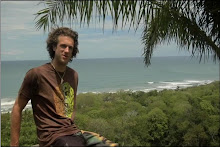When I was in Belize, I saw a show on the Food Network where some professional chef was in Oaxaca preparing a chapuline-covered tlayuda with a woman named Susana Trilling, who owns a cooking school in the heart of the Oaxacan valley. I immediately scribbled down the name of the school, although quickly realized that it was one of the recommended activities in my guidebook. I soon forgot about it, but almost two months later I would be in Oaxaca and flip past the dog-eared page in my Lonely Planet. Sure enough, two days later I was standing with a group of nine other people, being the only guy not accompanying a significant-other and the only one under the age of 40+ish, waiting to be picked up.
We set off to the Etla market, just outside of Oaxaca City, where a wonderful woman named Yolanda showed us around and explained all of the things being sold there, from the dozens of types of chilies (each used for a specific type of dish), to the limestone wash used to rinse out the pottery used to bake tortillas.



We got demonstrations at every stall that we stopped at, had full permission to take as many pictures as we wanted at them (not an easy task for anyone that has visited a local indigenous market just about anywhere in Central America or Mexico), and, best of all, indulged in more free samples than you get on a weekly trip to Costco. The market was impeccably clean compared to almost every other one I have seen on my trip, the people were all smiles, and nobody got pickpocketed, which is always an added bonus to a market trip.




After several hours touring the market, we were brought to the comedor where we would have lunch, served with the Oaxacan specialty of 'chocolate con agua'. When I ordered 'agua de chocolate', Yolanda told me that I needed to watch my inversed wording, or at other comedores I might end up with a cup of brown dish water. Oops.

After some time spent browsing the market on our own, we headed off to the cooking school itself, where we would be led through a five-course meal under the supervision of Susana and her team at Seasons of my Heart. The school is a beautiful building pretty much in the middle of nowhere, and even with the address I doubt anyone could have found it without a local guide. However, it is indeed a tucked-away gem, wonderfully decorated and full of everything you could possibly need to make a traditional Mexican dish. After introductions and enough freshly-squeezed juice to go around, we sat down and were briefed on the dishes we would be making, their backgrounds, and the composition of their ingredients. We were then divided up into teams of two, each working on one of the five courses. I ended up on the appetizer, whose name I don't remember, but essentially consisted of a bean-mixture-filled freshly made tortilla, covered in a spicy chili salsa, all made from scratch. Win.


We were quickly thrown into the mix, and it turned out to be less of a class and more of a 'here are your ingredients, here is your recipe, here is the kitchen, let us know if you need any help' kind of deal. This threw me off at first, but before long I was throwing stuff around and whiping up my dish like the goofy-looking kid in Ratatouille before the rat starts showing him what to do.

After a couple hours and a couple beers, everyone had finished their dishes, and the table was set. During the class, I talked to a few of the other people taking the class, who were all curious as to why I was there. 'Do you do a lot of cooking at home?' No. 'Do you have Susana's cookbook at home?' No. 'Are you training to be a chef?' No. It was a simple answer, I told them in the end, I just like to eat. And eat we did.










































